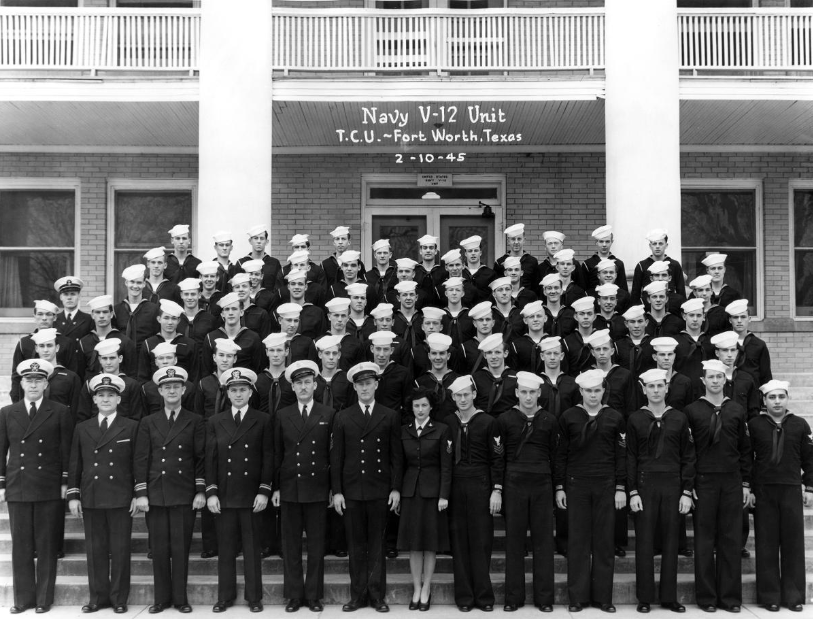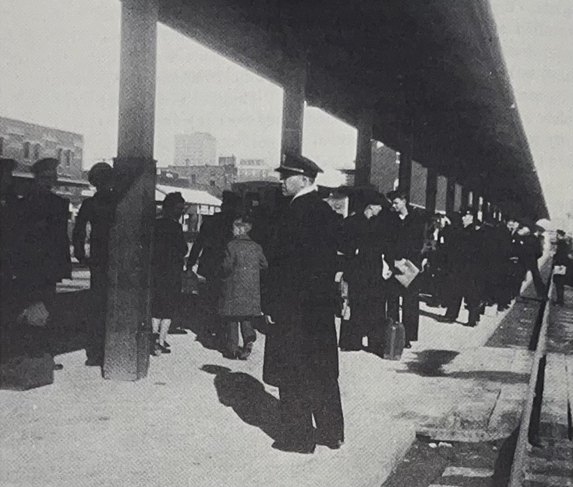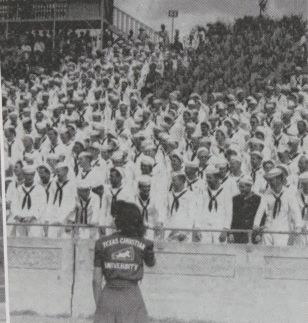TCU Meets the V-12s
World War II, a time in America’s history when research boomed, patriotism flourished, and college training programs became prevalent on campuses, including TCU’s, which housed the Navy V-12 College Training Program. The V-12 program prepared young men for service through knowledge. TCU welcomed the V-12 program with open arms, creating a campus culture that allowed V-12 members to prepare for war while still getting to experience the college life of a Horned Frog.

“V-12 Navy College Training Program,” 1945, TCU Photo Collection, Special Collections,
Mary Couts Burnett Library, Texas Christian University.
World War I left a great fear of the horrendous consequences of being technically unprepared. This fear led many government and military personnel to require the use of universities to educate future military officers in particular technical subjects. For instance, V-12 program’s sought to recruit and train officer candidates for the Navy, Marine Corps, and the Coast Guard.[1] Most V-12 members came from civilian life; within the 750 men that enrolled in TCU’s program, only 150 men came with prior active duty.[2] Most of these men then went on to serve as military officers and specialists; thus, illustrating the demand and need for these educated soldiers in technical leadership positions.[3] Every V-12 host school focused on specific areas of study; TCU focused on basic, premedical, and predental training. Education leaders across the United States enjoyed helping V-12’s reach success because staff and administration had control over what content, resources, and knowledge the trainees needed to be successful in the program and later in service.[4]

James G. Schneider, The Navy V-12 Program: Leadership for a Lifetime (Champaign, IL: Marlow Books, 1993), 230.
To meet these goals, certain academic guidelines changed. University curricula adapted all across the nation, including at TCU, to emphasize engineering, foreign language, and sciences, while also speeding up the degree timeline to three years instead of four.[5] Navy V-12 also added physical training, naval history, and areal studies.[6] The V-12 program required a strict schedule that fell into a cycle of sleeping, training, eating, and studying, reminding the V-12s and others on campus that the trainees were here to prepare for war.[7] However, the entire TCU community wanted more than academic success, TCU wanted V-12s to feel at home.4

The Horned Frog, 1943, page 83
TCU welcomed the V-12 program into the campus culture in 1943. The Skiff features this amiable attitude with an article titled “Welcome, Navy,” a picture of V-12 trainees intermingling with female students, and the text of a welcome from President Sadler who took special consideration in introducing the program as a member of TCU’s student community.[8] In addition, The Horned Frog illustrates the V-12’s time on campus. Some trainees chose to spend their free time with female students, who were said to be “boosting morale,” but other V-12’s used their free time to get involved in sports and showcase their musical talents.[9] Phil Weinkrantz, a V-12 member, has an article in the Skiff that comments on his talents as a violinist, a concert master, and how he enjoys life on campus.[10] V-12 men were also a major asset to TCU football, and many other V-12’s spent their time playing intramural sports or planning touch football games.[11] These activities allowed men to stay fit for the war, while also enjoying normal college experiences, thanks to a welcoming environment, sports, and extracurriculars that satisfied the talents of many trainees.
TCU’s campus embodied a mix of cultures that blended national defense with American society. Together, TCU and the V-12 program adapted, creating new ways of war-integrated college life in a positive light.
[1] V.R. Cardozier, Colleges and Universities in World War II (Westport: Greenwood Publishing Group, 1993), 52.
[2] Marcia Melton, “TCU Answers Call to Host U.S. Navy Sailors,” TCU Magazine, June 15, 2016, https://magazine.tcu.edu/spring-2014/tcu-answers-call-to-host-u-s-navysailors/#:~:text=The%20college%20V%2D12%20program,took%20the%20deck%20officer’s%20curriculum.
[3] V.R. Cardozier, The Mobilization of the United States in World War II: How the Government, Military, and Industry Prepared for War (Jefferson, NC: McFarland, 2014), 100-101.
[4] James G. Schneider, The Navy V-12 Program: Leadership for a Lifetime (Champaign, IL: Marlow Books, 1993), 7, 459.
[5] “T.C.U Catalogues,” 1943; “Revised Calendar,” 1944, (Fort Worth, Texas), Special Collections, Mary Couts Burnett Library, Texas Christian University.
[6] “Navy V-12 Bulletin No.101. Navy V-12 Curricula, Schedules, Course Descriptions” (Washington D.C., U.S. Navy: Bureau of Naval Personnel, Training Division, 1943).
[7] “V-12 Men’s Daily Schedule Runs From 0545 to 2200,” The Skiff, July 30, 1943, Special Collections, Mary Couts Burnett Library, Texas Christian University.
[8] “Welcome, Navy;” “Welcome To Students,” The Skiff, July 9, 1943, Special Collections, Mary Couts Burnett Library, Texas Christian University.
[9] “V-12 Free Time Activities,” The Horned Frog, 1943, Special Collections, Mary Couts Burnett Library, Texas Christian University.
[10] “Phil Weinkrantz, Navy V-12 Man, Musical Genius,” The Skiff, August 6, 1943, Special Collections, Mary Couts Burnett Library, Texas Christian University.
[11] “Touch Football Planned by V-12,” The Skiff, September 8, 1944, Special Collections, Mary Couts Burnett Library, Texas Christian University.
For Further Reading
Schneider, James G. The Navy V-12 Program: Leadership for a Lifetime (Champaign, IL: Marlow Books), 1993.
This book gives great insight to the 131 schools that hosted a V-12 program during WWII. It provides background information about the program, describes how schools were selected, and explains how communities responded. The book also includes images of the V-12s from every school with a page dedicated to explaining general facts about the program at each school. This is a great resource to compare the programs at different schools, the campus life, and academics programs.
“WWII and the Navy V-12 Program.” Omeka RSS. Hobart and William Smith Colleges Archives and Special Collections.
This website is great for referencing what the V-12 program was like at another school, specifically Hobart College. It explains what everyday life was like, what their social life looked like, how they participated on campus, and how the campus responded when the trainees arrived. There is also a tab that links to photographs relating to the V-12s everyday life like eating in the dining hall, lining up with their companies, and an example of what the V-12’s orders of the day looked like.
Evans, D. Luther. “The Navy V-12 and the Peacetime College.” The Journal of Higher Education 17, no. 9 (1946): 463–68.
This source pays attention to effects of the V-12 program on higher education. It assesses the pros and cons in respect to the effect the Navy had on college campuses. It highlights the attitudes of the Navy and people on college campuses, focusing on discipline, patriotism, a sense of loyalty, and a sense of purpose. This perspective can be used to get a wider view of the relationship between thee military and universities during WWII.